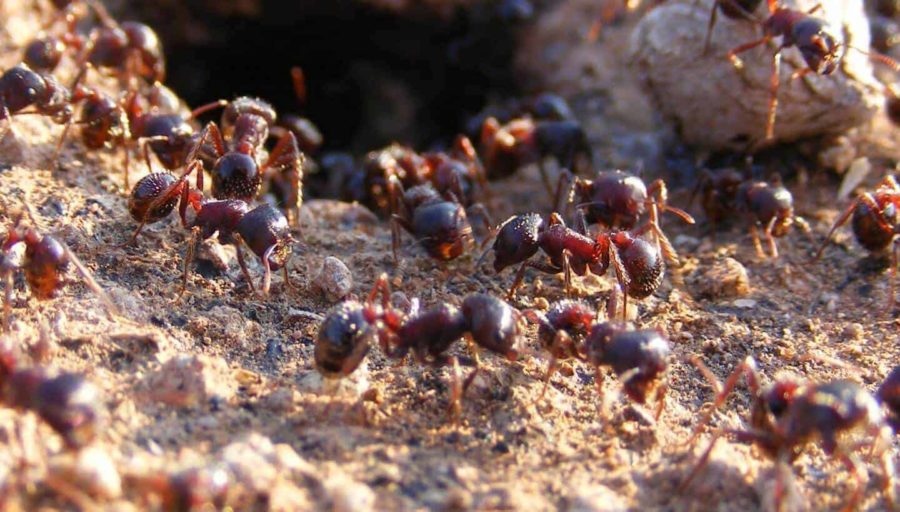An international team of researchers found that the evolutionary loss of the “altruistic” worker caste in ants is not accompanied by a loss of genes.
Social insects, such as ants, are typically characterized by two distinct female castes: workers and queens. Previous research has found that workers and queens each express different sets of genes leading scientists to speculate that there are worker specific or “altruistic” genes that promote sociality.
Testing this “novel gene” hypothesis is difficult given that all ants are social. However, not all ants make workers. Some ants are “workerless social parasites” whose queens exploit the worker force of other species by invading and setting up shop in their colonies. The authors took advantage of the unusual biology of these ants that have lost their worker caste to determine if worker genes really exist.
The research team, led by Chris R. Smith (Earlham College) and Alexander (Sasha) Mikheyev (Okinawa Institute of Science and Technology), sequenced and compared the genomes of six ants (3 hosts and 3 workerless social parasites) and looked for evidence that genes that are typically over expressed in the worker caste would degenerate through time when workers are no longer produced. Instead of finding degeneration in “worker” genes, they found that there are no “worker” genes and the majority of the protein coding genome is maintained in species that stopped producing workers even after one million years. Their research is online early in the journal Molecular Biology and Evolution.
“This was a total surprise, we hypothesized the opposite — when you lose a trait then the genes for that trait should disappear over time,” said Smith. “This result has two interesting implications: first, there don’t seem to be any genes that are explicitly ‘worker’ and thus truly ‘altruistic’, and two, that the loss of an entire body plan is not accompanied by a loss of genes.”
This result suggests that any organism’s genome may harbor the potential to produce historic phenotypes that are no longer under selection (for ~1 million years) – one need only speculate about what ancient human traits may continue to lurk in our own genomes, waiting to be expressed in a different environmental context.
When looking across developmental stages in an ant (the red harvester ant, Pogonomyrmex barbatus), the researchers found that most genes are expressed in both queens and workers, but often at different points in development. For example, there are no uniquely “worker” or “queen” genes. They then looked at whether genes with a greater bias in workers were more likely to get lost in species that no longer produce workers (social parasites).
To do this the researchers sequenced the genomes of two host species and two of their social parasites. The answer was no, the entire protein coding genome was under selection to maintain the genes present in both hosts and workerless social parasites.
The researchers found their results so surprising that they sequenced the genomes of another host-social parasite pair in the genus Vollenhovia, which are evolutionarily independent. Once again, the result was the same. Again surprised, they tested whether they could even expect to see the deterioration of genes in the mere 700,000 to million years of divergence between worker and worker-less species. Indeed, models do predict gene loss, yet none was evident in their actual samples.
“Social parasitism is relatively widespread in social insects, and our results suggest why – most changes are regulatory, and don’t require complex genome-wide alterations,” Mikheyev said.
The results reported in this new research add to a growing body of literature suggesting that many traits (and whole body plans, as shown here) may evolve by tweaks in the regulation of pre-existing genes and networks. Phenotype gain and loss may be facilitated by changes in the environment within and outside of the organism, not necessarily requiring changes to protein coding genes, just changes to when and how they are used).
“This research reminds us of the importance of studying organisms with unusual natural history in order to get insight into the processes that govern diversity more generally,” said Andrew Suarez from the University of Illinois and a co-author of the study.
While this work was on species far removed from the origin of sociality, it does suggest that sociality may have evolved from regulatory changes in a solitary ancestor rather than requiring novel altruism genes for social living and division of labor.
If our reporting has informed or inspired you, please consider making a donation. Every contribution, no matter the size, empowers us to continue delivering accurate, engaging, and trustworthy science and medical news. Independent journalism requires time, effort, and resources—your support ensures we can keep uncovering the stories that matter most to you.
Join us in making knowledge accessible and impactful. Thank you for standing with us!

